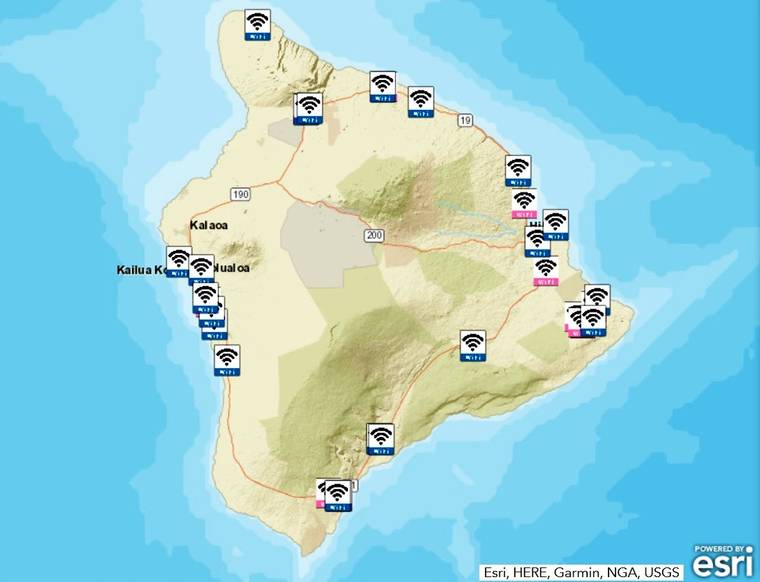HILO — Fear of radio wave exposure and a desire not to be around cellphone users inspired more than 50 people to send the County Council testimony opposing free Wi-Fi at county parks and facilities.
Dozens of Wi-Fi hotspots are being constructed in public spaces on the Big Island as a requirement of a court-ordered settlement. Seven of those hotspots require council approval for equipment to be installed at parks facilities themselves, rather than on cable company property.
Under the agreement, the public will have free access to up to one hour per device daily at 1,000 public places statewide.
Locations were chosen based on community need, said Parks and Recreation Director Roxcie Waltjen. Underserved and unserved rural areas throughout the county were selected, but council action is needed to install equipment at the Waimea, Pahala and Keaau community centers, the Honokaa and Papaikou gyms, the Pahoa Community Aquatic Center and the Pahoa Neighborhood Facility.
“Any time there is an opportunity to provide access to information to the general public, we are ready to accept it,” Waltjen said, adding the locations were chosen “based on people in the community wanting it.”
The council’s Committee on Parks and Recreation on Tuesday unanimously forwarded Resolution 425 to the council, providing that permission.
But not everyone in the community is happy about it.
“I am an electro-sensitive person. Going to the beach has been a safe haven for me,” said Carrie Nicol in written testimony. “I am appalled that there is not more consideration of the effects of Wi-Fi on people biologically and only thought of as a way that people can access what they need immediately. What are we training our children?”
Gala Lirette submitted written testimony and also testified in person.
“There is no reason to have Wi-Fi in our parks. The park is the place to go to get away from Wi-Fi,” Lirette said. “What purpose will it serve? To submit our families and children to more harmful wireless radiation?”
Lirette said people should stay home if they need to use their cellphones.
Linda Ikeda said Wi-Fi is more dangerous than people know.
“Let’s keep Hawaii’s parks safe from a proven toxin that most people are unaware about because of the propaganda of the wireless companies just like the cigarette issue of years past,” she said in written testimony.
Scientific research, however, doesn’t seem to back the testifiers’ health claims.
The World Health Organization surveyed some 25,000 articles dating back as long as 30 years ago to understand any potential health threats.
“Based on a recent in-depth review of the scientific literature, the WHO concluded that current evidence does not confirm the existence of any health consequences from exposure to low level electromagnetic fields,” the WHO said on its website. “However, some gaps in knowledge about biological effects exist and need further research.”
“Some members of the public have attributed a diffuse collection of symptoms to low levels of exposure to electromagnetic fields at home. Reported symptoms include headaches, anxiety, suicide and depression, nausea, fatigue and loss of libido. To date, scientific evidence does not support a link between these symptoms and exposure to electromagnetic fields,” the WHO report said. “At least some of these health problems may be caused by noise or other factors in the environment, or by anxiety related to the presence of new technologies.”
The National Cancer Institute was in agreement with the WHO’s conclusions in its Electromagnetic Fields and Cancer fact sheet.
“Radiofrequency radiation exposure from Wi-Fi devices is considerably lower than that from cell phones,” the fact sheet states. “Both sources emit levels of radiofrequency radiation that are far below the guideline of 10 W/m2 as specified by the International Commission on Non-Ionizing Radiation Protection.”
Kohala Councilman Tim Richards acknowledged that “I know that this is a conversation out there,” about health issues. Still, he said, children hang out outside county facilities to get their homework done, showing the need for the hotspots.
“These are communities where families have no internet at home,” said North Kona Councilwoman Karen Eoff.
The state required the communication company to provide at least 1,000 new public Wi-Fi access points within four years of the close of the transfer transaction. One hundred of them must be deployed in public parks, civic and other community centers and other public open areas and gathering places, according to the contract.
About 30 of those will be on the Big Island, said Kiman Wong, director of wireless, intelligent home and government relations for Charter Communications.
“We provide the equipment .. no charge to the county,” Wong said. “It’s our way of giving back.”
Council Chairman Aaron Chung noted the arrangement benefits not only the community, but also the cable company.
“I’m sure a lot of people who are going to be utilizing this service don’t have the wherewithal to subscribe to your service, but also it helps you guys because it markets your product and people could become customers,” Chung said. “You guys have a benefit as well.”






